Become a better leader with these footwork drills to take your West Coast Swing to the next level.
Leaders footwork drills are essential to improve your West Coast Swing. If you want to progress with your skill in both social dancing and competition, footwork is a great place to start. Plus, you can practise these anytime and anywhere with or without a partner.
All of us want to move better on the dance floor. We love to feel agile and light on our feet. Plus who doesn’t want to improve their ability to move ‘with the music’.
Footwork is one of those skills we can train on own own and have people notice improvement in our dancing when we dance socially.
I wouldn’t recommend throwing these in to your Newcomer competitions, but in Novice Jack and Jills and above, great footwork will help you stand out.
When I watch the great West Coast Swing leaders dance, they have amazing footwork. Champions like Robert Royston, Jordan Frisbee and Benji Schwimmer are great examples.
Unfortunately, trying to find footwork drills online (specifically for leaders) is a lot more difficult than you would imagine.
So I wanted to share some drills that I do after piecing together snippets of advice from West Coast Swing Professionals.
I have found by doing dancing drills daily I have;
- Improved my agility
- Improved my timing
- Added musicality movement
- Added style to my dancing without thinking about it
8 Footwork Drills for Leaders Dancing West Coast Swing
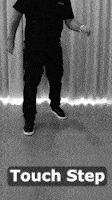
Touch Step Footwork
The first and most simple footwork is ‘touch step’. This is where you ‘touch’ the ground with your toe on the 1, 3, 5, 7 count and then ‘step’ to a new position on the 2, 4, 6, 8 count.
It’s simple and can be practised from side to side for beginners, but then also in random directions. Once you gain some confidence with those, try it in double and half time counts.
This is a great drill for improving your agility and general movement in many directions.
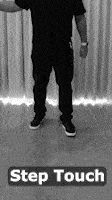
Step Touch Footwork
This is the opposite of ‘touch step’. Instead of touching the ground on the odd count, you’re stepping on the odd count and touching on the even count.
If you go to any random pub or club, you’ll see beginner dancers (typically blokes) performing the ‘step touch’. Often they’ll have a beer in one hand,
Again, this is a great drill for improving your agility and should be practised by stepping in different directions.
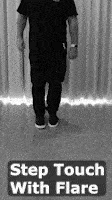
Step Touch with Flare
Taking the step touch move a little further, we’re going to add a flare.
So at the same time you ‘step’ on the 1 count of music, you’ll pivot on your grounded foots heel.
This is more easily done when you adjust and transfer your weight to the back of your grounded foot as you are taking your ‘step’.
It’s a little weird getting used to this move, however there are a lot of times a ‘flare’ can look really cool. This can be a really cool move when used in a blues tune at the right moment.
Robert Royston threw in a Step Touch with Flare in his Jack and Jill and the crowd loved it!
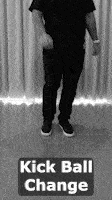
Kick Ball Change Footwork
The kick ball change step is completed to two counts.
Much like a triple step, you kick on the beat of the 1, then plant your foot back down on the ‘and’ and then lift your other foot up and replace it on the spot on the two.
The kick ball change is simple to add at the anchor triple step and if you have the right song that sings ‘KICK’ at that moment, you’ll show some impressive musicality skills!
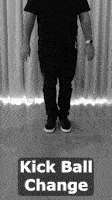
Point Ball Change Footwork
This is similar to the kick ball change except you’re pointing your toe and making contact with the ground.
Point the toe and touch the ground on the 1 count, then plant your foot back down on the ‘and’ and lift your other foot up and replace it on the spot on the two count.
Thibault Ramirez can be seen using point ball change regularly and throws in a kick ball change often. It’s become a signature of his dance style and looks amazing.
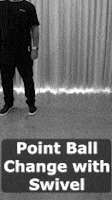
Point Ball Change with Swivel
This is very similar to the point ball change except instead of lifting your foot fully off the ground and pointing your toes, you’re only lifting your heel and then swivelling.
The swivel accents the change of direction (sideways) as you shift your swivel foot to your grounded foot on the ‘and’ to then step with your grounded foot.
Semion Ovsiannikov can regularly be seen adding musicality breaks with this footwork technique. Using a point ball change with swivel like this breaks up the ‘slotted’ movement and adds some extra depth to West Coast Swing.
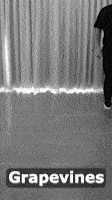
Grapevines
As I mentioned, footwork is not only practical for dance steps, but can also improve your agility.
Grapevines do exactly that (and is also usable as a dance step). For your footwork drills, try grapevines where you cross in front of your foot, then behind.
For best technique, try to minimise shoulder rotation but allow your waist to rotate as needed. This helps develop contrabody technique also.
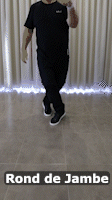
Rond de Jambe
There are so many times you can use a Rond de Jambe in West Coast Swing. My most common use would be after a left side pass where I rond de around to face my partner instead of triple stepping.
Practise going forwards and backwards with your Rond de Jambe’s and you’ll develop more control over your weight transfer.
I hope you like these footwork drills to improve leading with style and some flair. Even if you’re not dancing West Coast Swing, these can help your overall confidence on the dance floor.
Let me know how you go and if you have a favourite way of using these skills in your dances.

Thank you for posting the basic drills and some variations for footwork. Are there any drills for technique such as preps, tension amplification (sometimes called leverage), or momentum (whips, hustle whips, and whip extensions).
I do know of some drills that are taught for partner connection which help with preps, tension etc.. I was taught these by Semion & Maria who I believe were shown those by Robert Royston. I don’t share them publically as they teach these in workshops at events and via private lessons. They are excellent and I highly recommend them – maybe you could contact them directly for those. Regarding momentum, those whip variations are normally taught in classes which I would then drill with partners after class. But I don’t know of any online that explain those well.
Hope that helps David & thank you for asking.